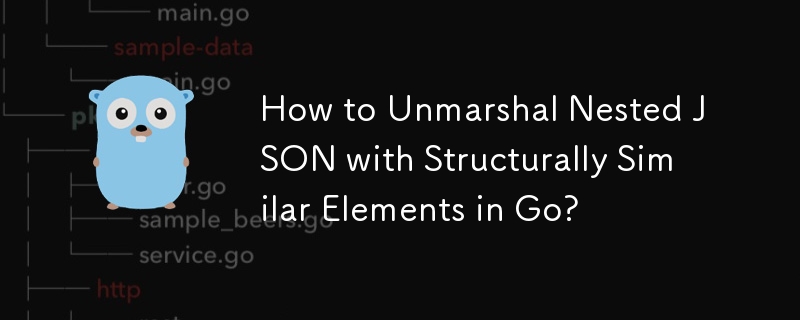 Backend Development
Backend Development
 Golang
Golang
 How to Unmarshal Nested JSON with Structurally Similar Elements in Go?
How to Unmarshal Nested JSON with Structurally Similar Elements in Go?
How to Unmarshal Nested JSON with Structurally Similar Elements in Go?

Unmarshalling JSON with Nesting and Structural Similarity
When dealing with complex JSON structures, it is common to encounter scenarios where one element of a struct is of the same type as the struct itself. This can pose challenges during the unmarshalling process.
In this specific case, we are given a JSON string that represents an array of database configurations. Each database configuration contains various attributes, including a list of replicas. Each replica is also a JSON object with attributes similar to the database configuration.
To unmarshal this JSON string, we need a data structure that can accommodate the nesting and structural similarity.
Modeling the Nested Structure with Dynamic Types
Since the JSON input is not a slice of DBS structs, we need a more flexible data type to capture its structure. A map[string]interface{} is an excellent option because it can represent key-value pairs with dynamic values.
Example:
type DBS struct {
URL string
Port string
Uname string
Pass string
Authdb string
Replicas []DBS
}
func main() {
raw, err := ioutil.ReadFile("./config.json")
if err != nil {
fmt.Println(err.Error())
os.Exit(1)
}
var config []map[string]interface{}
json.Unmarshal(raw, &config)
for _, db := range config {
d, ok := db["db"]
if !ok {
// Handle the case where "db" is missing
}
db := d.(map[string]interface{})
url := db["url"].(string)
port := db["port"].(string)
var replicas []DBS
for _, replica := range db["replicas"] {
replicas = append(replicas, mapToDBS(replica))
}
// ... Other operations
}
}Using a Dynamic Type to Parse the JSON
In this example, the config variable is a slice of maps, which allows it to hold the database configurations as key-value pairs.
For each database configuration, we retrieve the "db" sub-object and cast it to a map[string]interface{}. This allows us to access the individual attributes such as "url" and "port".
The "replicas" attribute is handled similarly. Each replica is a JSON object, so it can be converted into a DBS struct using the mapToDBS() function.
By leveraging the flexibility of dynamic types, we can effectively unmarshal the JSON string and parse its nested structure.
The above is the detailed content of How to Unmarshal Nested JSON with Structurally Similar Elements in Go?. For more information, please follow other related articles on the PHP Chinese website!

Hot AI Tools

Undresser.AI Undress
AI-powered app for creating realistic nude photos

AI Clothes Remover
Online AI tool for removing clothes from photos.

Undress AI Tool
Undress images for free

Clothoff.io
AI clothes remover

AI Hentai Generator
Generate AI Hentai for free.

Hot Article

Hot Tools

Notepad++7.3.1
Easy-to-use and free code editor

SublimeText3 Chinese version
Chinese version, very easy to use

Zend Studio 13.0.1
Powerful PHP integrated development environment

Dreamweaver CS6
Visual web development tools

SublimeText3 Mac version
God-level code editing software (SublimeText3)

Hot Topics
 Go language pack import: What is the difference between underscore and without underscore?
Mar 03, 2025 pm 05:17 PM
Go language pack import: What is the difference between underscore and without underscore?
Mar 03, 2025 pm 05:17 PM
Go language pack import: What is the difference between underscore and without underscore?
 How to implement short-term information transfer between pages in the Beego framework?
Mar 03, 2025 pm 05:22 PM
How to implement short-term information transfer between pages in the Beego framework?
Mar 03, 2025 pm 05:22 PM
How to implement short-term information transfer between pages in the Beego framework?
 How to convert MySQL query result List into a custom structure slice in Go language?
Mar 03, 2025 pm 05:18 PM
How to convert MySQL query result List into a custom structure slice in Go language?
Mar 03, 2025 pm 05:18 PM
How to convert MySQL query result List into a custom structure slice in Go language?
 How can I define custom type constraints for generics in Go?
Mar 10, 2025 pm 03:20 PM
How can I define custom type constraints for generics in Go?
Mar 10, 2025 pm 03:20 PM
How can I define custom type constraints for generics in Go?
 How do I write mock objects and stubs for testing in Go?
Mar 10, 2025 pm 05:38 PM
How do I write mock objects and stubs for testing in Go?
Mar 10, 2025 pm 05:38 PM
How do I write mock objects and stubs for testing in Go?
 How to write files in Go language conveniently?
Mar 03, 2025 pm 05:15 PM
How to write files in Go language conveniently?
Mar 03, 2025 pm 05:15 PM
How to write files in Go language conveniently?
 How can I use tracing tools to understand the execution flow of my Go applications?
Mar 10, 2025 pm 05:36 PM
How can I use tracing tools to understand the execution flow of my Go applications?
Mar 10, 2025 pm 05:36 PM
How can I use tracing tools to understand the execution flow of my Go applications?






